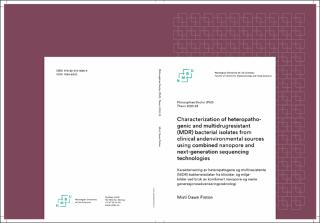| dc.description.abstract | Escherichia coli (E. coli) are usually harmless commensals that colonize the gastrointestinal tract of humans and other warm-blooded mammals. However, pathogenic counterparts have acquired virulence associated genes (VAGs) that allow for colonization and infection of several anatomical sites. Intestinal pathogenic E. coli (IPEC) strains are important foodborne pathogens that cause diarrheal disease in humans and are one of the major causes of mortality amongst children <5 years of age. On the other hand, extraintestinal pathogenic E. coli (ExPEC) strains are common causes of urinary tract infections (UTIs), bacteremia, neonatal meningitis, and wound infections. Traditionally, IPEC and ExPEC have been considered distinct from one another, and ExPEC VAGs were thought to be completely absent in IPEC strains. However, novel combinations of VAGs from multiple pathotypes (both IPEC and ExPEC) may exist in a single strain and are often referred to as a ‘heteropathogen’ or ‘hybrid’. Heteropathogens are an emerging public health threat that may cause a more serious infection and have an increased spreading potential. Therefore, a large portion of this PhD work (paper I and paper III) focused on expanding our knowledge of heteropathogenic E. coli by examining isolates from fecal samples of patients in Norwegian clinics that exhibited signs of gastrointestinal infection. In paper I, we looked at a wider range of VAGs and were especially interested in detecting known ExPEC virulence factors (VFs), as there is little information regarding the frequency of ExPEC strains in the human gut. To gain even more knowledge on the heteropathogenic nature of the strains of paper I, we chose several for whole genome sequencing (WGS) through a combination of Oxford Nanopore’s MinION and Illumina’s Miseq.
Our research also focused on the detection of extended-spectrum β-lactamases (ESBLs) in environmental soil and water sources. ESBLs encode resistance to the most widely used class of drugs in human and veterinary medicine, β-lactams, and constitute a serious risk of community-acquired infections with limited treatment options. Their presence in the environment was of special interest, as soil and aquatic ecosystems are rich reservoirs for the acquisition, evolution, and dissemination of ARB. This particular project was originally thought to be a separate initiative than the heteropathogenic E. coli of papers I and III, however we found heteropathogenic strains of ESBL-producing E. coli in the environment, tying the two seemingly different research topics together.
Overall, the backbone of this PhD work was Oxford Nanopore’s MinION and Illumina’s MiSeq. The long reads of the MinION and the short reads of the MiSeq put together allowed us to assemble multiple whole genomes, and even discover a number of novel genes. Currently, both heteropathogenic E. coli and ESBL-producing bacteria are hot topics, and the use of WGS enabled us to generate more knowledge for the never-ending quest of scientists. | en_US |

